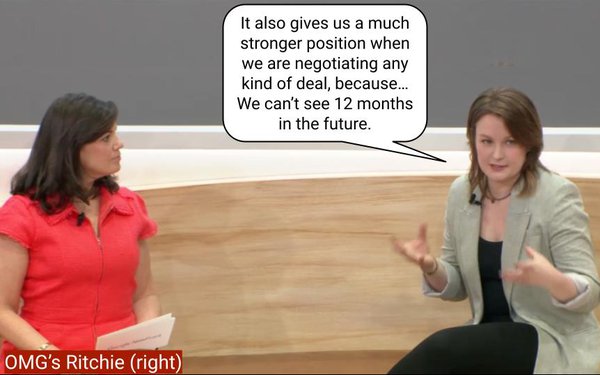Commentary
It's Google's World And Planners & Buyers Are Just Living In It
- by Joe Mandese @mp_joemandese, April 30, 2024

And by "world," I mean stack.
If you really want to understand the way Google has been leveraging its dominant legacy of digital advertising and media optimization into the new world of TV/cross-platform optimization, you should get a copy of Omnicom Media Group Senior Vice President-Programmatic & In-housing Clare Ritchie's presentation at Google's NewFront event Monday morning.
Ritchie, who is responsible for overseeing all of OMG's programmatic stack worldwide, shared how she has been working directly with Google's development team to build, pilot and test a new AI-powered application within Google's DV360 platform that optimizes all of an agency's upfront media-buying commitments for a year, including tracking deliverables, as well as adjusting and readjusting brand allocation and supplemental programmatic and scatter buys throughout the year.
advertisement
advertisement
Dubbed "Commitment Optimizer," the application is explicitly designed to give planners and buyers a simple automated tool for adjusting and allocating upfront advertising commitments on-the-fly -- even predictively utilizing Google's AI technology -- in ways that human planners and buyers cannot. At least not without many manual steps that would otherwise take them away from managing more important things for their clients media campaigns.
Or what Ritchie described as "doing what's important rather than just managing a tangled web of spreadsheets."
"That's how we got started," confided Google Vice President-Agency, Platforms & Client Solutions Kristen O’Hara, adding: "Listening to that feedback."
"At Google, we set a goal to really help streamline and simplifying upfront inventory management for partners like yourselves."
That comment is significant and should be chilling for any of the major network TV-owner platforms that traditionally control the upfront selling process, because depending on the success of products like Commitment Optimizer, it's going to take more and more control away from the conventional supply chain and shift it more to Google -- and potentially companies like The Trade Desk -- how have a more 360-degree view of how advertisers and agencies are allocating their inventory across all forms of video advertising: linear, CTV, OTT, digital programmatic, etc.
Aside from breaking down legacy siloes for planning, buying and allocating across that mix, it's giving planners and buyers what effectively are super powers to sit on top of it, and without the drudgery and time-consuming steps of manually managing it.
"We all know that automation is an absolute game-changer," OMG's Ritchie told attendees at Google's NewFront, emphasizing, "We have super smart people in-platform and we don’t want them managing spreadsheets.
"What we want them to be doing is adding to high-level strategy, doing the interesting things, the product development and ultimately, pushing us forwards and navigating this ever-changing media landscape that we work in."
While neither Ritchie or Google's O'Hare divulged any proprietary information, or shared and screenshots or demos of what OMG is piloting, they did provide powerful anecdotal evidence that it is potentially disruptive to the conventional ways upfront deals are managed and optimized over time.
"The tests that we’ve seen so far, Commitment Optimizer has helped us deliver up to three times more impressions," Ritchie shared, adding, that it ended up, "boosting reach, delivery, and ultimately, there has been no negative spend impact, which is really important."
Another reason why the conventional upfront supply-side should be concerned is that it helps to rebalance some of the information asymmetry that has historically existed in the upfront advertising marketplace by giving agency media-buyers some predictive, AI-informed upfront intel to go to market with.
"It also gives us a much stronger position when we are negotiating any kind of deal, because we have so much more clarity around where we are going with that and how we can use it," Ritchie explained, adding, "It gives us a level of fluidity. We can adjust to plans. We can’t see 12 months in the future."
She went on to utilize a variety of Big Tech terms for the impact of the optimizer, including "pivot," "nimble" and "reactive," but ultimately she said it's "another kind of tool in our arsenal."
She implied it also is a tool that could mean greater shares of ad budgets that otherwise might have gone to conventional linear, or network-supplied CTV inventory could end up being spent in other parts of the waterfall, noting, "Executing upfront deals with better ability, ultimately allows us to use non-guaranteed programmatic to fulfill reach and add impact to those commitments we have."



